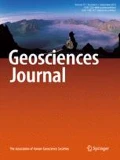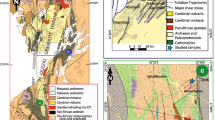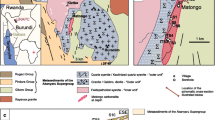Abstract
The phoscorite—carbonatite complex (PCC) in the Sokli massif, northern Finland, is divided into 5 stages according to mineral assemblages and occurrences. The earlier three stages comprise phoscorites and calcite carbonatites (P1 to P3 and C1 to C3, respectively), and they usually occur as pairs with the same mineral assemblage (calcite, apatite, megnatite, olivine, and mica). The latter two stages consist of only dolomite carbonatites called D4 and D5. All micas investigated from the Sokli PCC fall in the range of the phlogopite-tetraferriphlogopite series. Tetraferriphlogopite begins to crystallize from late stage 2 and becomes a dominant silicate in the P3C3 rocks and D4-D5 dolomite carbonatites. Although tetraferriphlogopites occur as primary or secondary products, discrete and euhedral (magmatic) tetraferriphlogopites are considered to have crystallized from a melt strongly depleted in aluminum and saturated in Ti-bearing phases under low temperature condition. The chemical variation of phlogopites shows that Fe and F contents increase, whereas Al, Ba, Ti and Mg contents decrease from stage 1 to stage 5. The progressive depletion in aluminum and the enrichment in fluorine towards the later stages seem to be a specific feature of the Sokli phlogopite. The difference of phlogopite rim compositions between phoscorites and paired carbonatites indicates that there was a slight difference of elemental partitioning into the interstial melts during the segregation of the rocks from a parental magma.
Similar content being viewed by others
References
Barker, D.S., 2001, Calculated silica activities in the carbonatite liquids. Contributions to Mineralogy and Petrology, 141, 704–709.
Bell, K., Dunworth, E.A., Bulakh, A.G. and Ivanikov, V.V., 1996, Alkaline rocks of the Turiy Peninsular, Russia, including typelocality turjaite and turjite: a review. Canadian Mineralogist, 34, 265–280.
Brigatti, M.F., Medici, L., Saccani, E. and Vaccaro, C., 1996, Crystal chemistry and petrologic significance of Fe3+-rich phlogopite from the Tapira carbonatite complex, Brazil. American Mineralogist, 81, 913–927.
Brod, J.A., Gasper, J.C., Araujo, D.P., Gibson, S.A., Thompson, R.N., and Junqueira-Brod, T.C., 2001, Phlogopite and tetra-ferriphlogopite from Brazilian carbonatite complexes: petrogenetic constraints and implications for mineral-chemistry systematics. Journal of the Asian Earth Science, 19, 265–296.
Dymek, R.F., 1983, Titanium, aluminum and interlayer cation substitutions in biotite from high-grade gneisses, West Greenland. American Mineralogist, 68, 880–899.
Edgar, A.D. and Arima, M., 1983, Conditions of phlogopite crystallization in ultrapotassic volcanic rocks. Mineralogical Magazine, 7, 11–19.
Farmer, L.G. and Boettcher, A.L., 1981, Petrologic and crystal chemical significance of some deep-seated phlogopites. American Mineralogist, 66, 1154–1163.
Foley, S.F., 1989, Experimental constraints on phlogopite chemistry in lamproites. I. The effect of water activity and oxygen fugacity. European Journal of Mineralogy, 2, 327–341.
Gaspar, J.C. and Wyllie, P.J., 1982, Barium phlogopite from the Jacupiranga carbonatite, Brazil. American Mineralogist, 67, 997–1000.
Heathcote, R.C. and McCormick, G.R., 1989, Major-cation substitution in phlogopite and evolution of carbonatite in the Potash Sulfur Springs complex, Garland County, Arkansas. American Mineralogist, 74, 132–140.
Kramm, U., Kogarko, L.N., Kononova, V.A. and Vartiainen, H., 1993, The Kola Alkaline Province of the CIS and Finland: Precise Rb-Sr ages define 380–360 Ma age range for all magmatism. Lithos, 30, 33–44.
Kukharenko, A.A., Orlova, M.P., Bulakh, A.G., Bagdasarov, E.A., Rimskaya-Korsakova, O.M., Nefedov, E.I., Ilinskiy, G.A., Sergeev, A.S. and Abakumova, N.B., 1965, The Caledonian Ultramafic Alkaline Rocks and Carbonatites of the Kola Peninsula and Northern Karelia. Nedra Press, Moscow, 772 p. (in Russian)
Lee, M.J., Lee, J.I. and Kim, Y., 2003, Occurrence and petrogenesis of phoscorite-carbonatite complexes in the Kola Alkaline Province, Aretic. Ocean and Polar Research, 25. (in press).
McCormick, G.R. and Heatheoth, R.C., 1987, Mineral chemistry and petrogenesis of carbonatite intrusions, Perry and Conway Counties, Arkansas. American Mineralogist, 72, 59–66.
McCormick, G.R. and Le Bas, M.J., 1996, Phlogopite crystallization in carbonatitic magmas from Uganda. Canadian Mineralogist, 34, 469–478.
Mitchell, R.H., 1995, Kimberlites, Orangeites and Related Rocks. Plenum Press, New York, 410 p.
Neal, C.R. and Taylor, L.A., 1989, The petrography and composition of phlogopite micas from the Blue Ball kimberlite, Arkansas: A record of chemical evolution during crystallization. Mineralogy and Petrology, 40, 207–224.
Paarma, H., 1970, A new find of carbonatite in North Finland, on the Sokli plug in Savukoski. Lithos, 3, 129–133.
Rimskaya-Korsakova, O.M. and Sokolova, E.P., 1964, Iron-magnesium micas with reversed absorption. Zapiski Vserossiuskogo Mineralogicheskogo Obschestva, 93, 411–423. (in Russian)
Vartiainen, H., 1980, The petrography, mineralogy and petrochemistry of the Sokli carbonatite massif northern Finland. Bulletin of the Geological Survey of Finland., 313, 126 p.
Vartiainen, H., 2001, Sokli carbonatite complex, Northern Finland. In: Gehör, S., Liferovich, R. and Wall, F. (eds.), Formation, Exploration and Exploitation of Economic Deposits Associated with Mantle Carbon: EuroCarb Workshop Excursion Guide. University of Oulu, Oulu, p. 8–24.
Vartiainen, H. and Paarma, H., 1979, Geological characteristics of the Sokli Carbonatite Complex, Finland. Economic Geology, 74, 59–68.
Vartiainen, H. and Vuotovesi, T., 1980, The Sokli carbonatite complex. Lithos, 13, 224–225.
Zaitsev, A. and Polezhaeva, L., 1994, Dolomite-calcite textures in early carbonatites of the Kovdor ore deposit, Kola Peninsula, Russia: their genesis and application for calcite-dolomite geothermometry. Contributions to Mineralogy and Petrology, 115, 339–344.
Author information
Authors and Affiliations
Corresponding author
Rights and permissions
About this article
Cite this article
Lee, M.J., Garcia, D., Moutte, J. et al. Phlogopite and tetraferriphlogopite from phoscorite and carbonatite associations in the Sokli massif, Northern Finland. Geosci J 7, 9–20 (2003). https://doi.org/10.1007/BF02910260
Received:
Accepted:
Issue Date:
DOI: https://doi.org/10.1007/BF02910260




